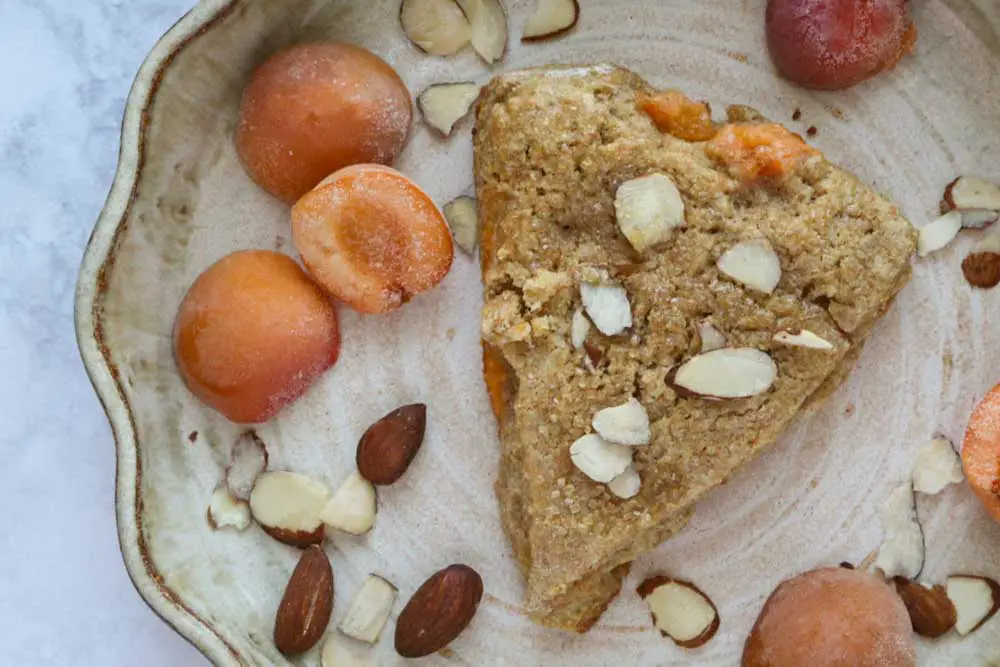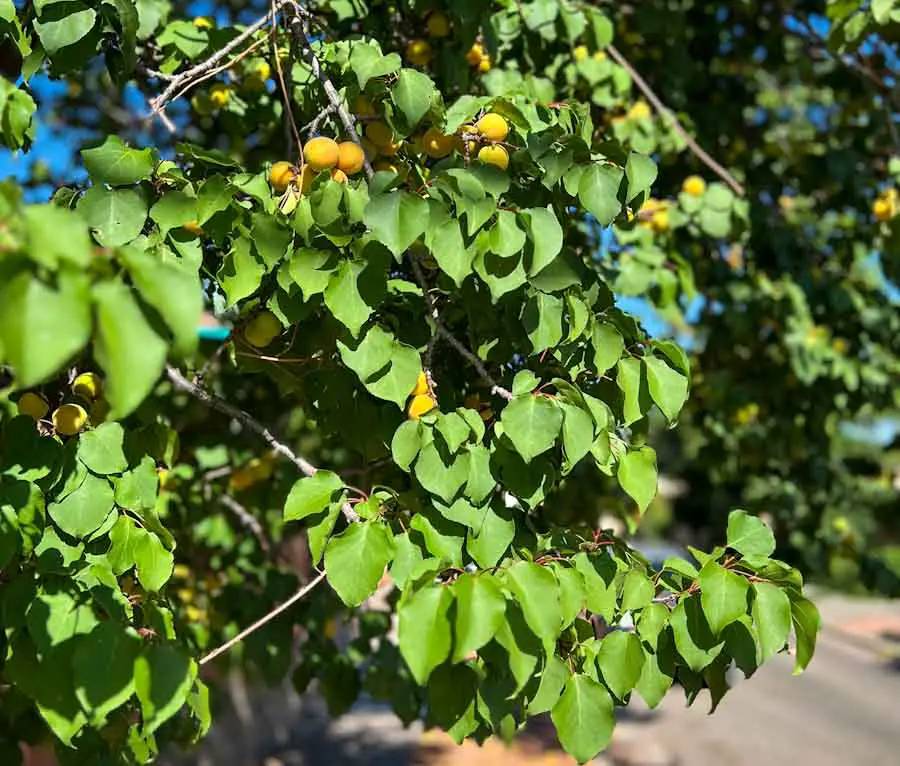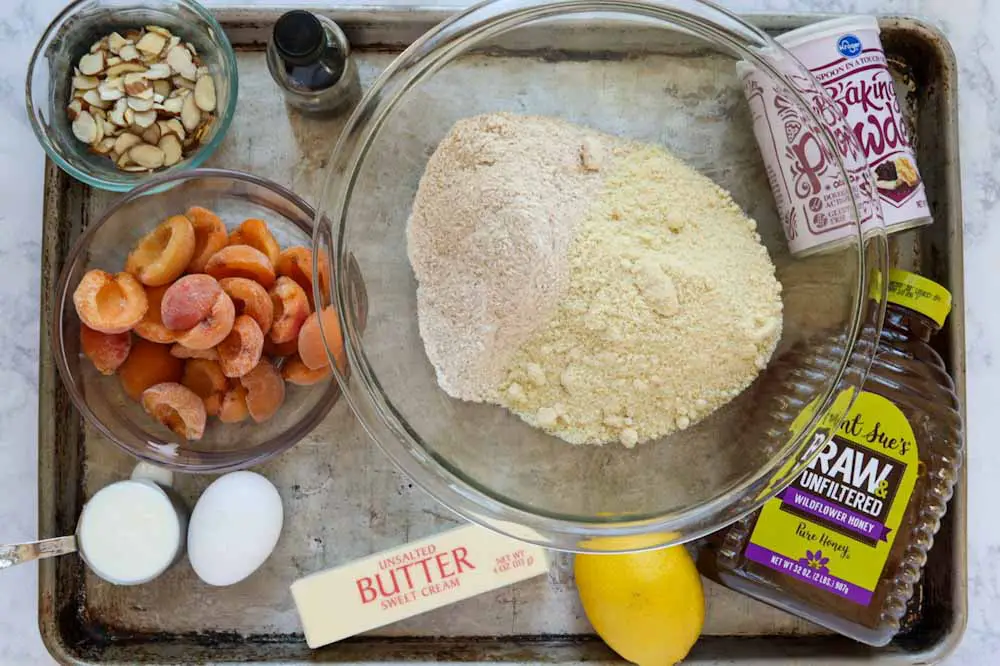
I am one of those people that gets excited when a beloved fruit comes into season and I start seeing it at the grocery store. Stone fruits, in particular – although, the peaches, plums, and apricots available at the store tend to be pretty disappointing.
That’s the main reason I started The Fruit Grove. I wanted to grow my own fruit at home that was far superior in flavor and nutrition. And then I wanted to create delicious recipes to use up that harvest.
This is just one such recipe. It’s inspired by a family trip to Santa Fe, New Mexico. If you don’t know, arid regions like northern New Mexico are the perfect environment for stone fruit trees, especially apricots.

Something magical happens there in the late summer. You walk all around the city, and it looks like half of the trees are loaded with little golden Christmas ornaments. All you have to do is reach up and pick a few (on public property, of course).
Luckily, I had a friend there with two apricot trees in her front yard. Last year they were so covered in fruit she couldn’t give the apricots away fast enough. We went over there four or five times over the course of our month-long visit and filled huge bags full of fresh apricots.

What did we do with so much fruit? Well between me, my husband, and my two boys, we ate most of them fresh. We made a lot of jam, some apricot liquor, and an amazing fruit salad with cherries, plums, and white peaches. And I came up with these Apricot, Honey, and Almond Scones.
It’s hard to describe how delicate, buttery, and satisfying these scones are. Apricots are only fresh for a short time, and baking these scones was the perfect way to enjoy our apricot bounty.

Growing Fresh Apricots
The only way to truly capture the fleeting taste of fresh apricots is to pick them off the tree and eat them right away. This is why I highly encourage you to try your hand at growing them yourself. In this section, I’m including some resources to get you started.
Apricot trees are beautiful, sprawling, and long-lived, but there are a few things to know before you plant one. They blossom very early in the spring, which means the flowers are prone to being damaged by early frosts. To combat this problem, choose a sunny planting location that is sheltered from wind, near a south-facing wall or fence (which creates a warmer microclimate), and is slightly elevated, if possible.
Learn more: Planting an Apricot Tree: How to Choose the Right Spot
An elevated planting site not only lessens the chance of frost damage (frost likes to settle in low-lying areas), but it also improves soil drainage. That’s the other common cause for apricot tree struggles – constantly soggy, poorly-drained soil.

Different apricot varieties need different amounts of winter cold in order to produce fruit. Choose a variety that corresponds to the chill hours in your area. And if you live in an area with colder spring weather, choose a cultivar that blossoms a little later (to avoid those pesky frosts).
Find some great apricot cultivars to try here: The Tastiest Low-Chill Apricot Varieties to Grow at Home
Learn when different cultivars flower here: When Do Apricot Trees Flower? Best Varieties by Bloom Time
Visit The Fruit Grove collection of apricot articles here for more information on how to grow apricots at home!
Baking with Almond Flour
I use almond flour in this recipe to give a subtly nutty flavor and to make them a little healthier than with just wheat flour. When you bake with almond flour, set the oven at a lower temperature. Almond flour tends to burn quickly, so these scones bake at 350°F (rather than 375° or 400° like many other scone recipes).

Almond meal also doesn’t absorb moisture the way flour does. Because of that, these scones need less overall liquid in the dough.
You can make your own almond meal by pulsing blanched, peeled almonds in the food processor until chopped as fine as possible. But, it’s hard to get a superfine, flour-like texture with a typical home appliance. I prefer the texture of store-bought almond flour or almond meal here.
Recipe Photo Instructions
First, combine the dry ingredients (almond meal, whole wheat flour, baking powder, and salt) together in one large bowl.

Do the same with the wet ingredients (honey, yogurt, egg, and vanilla). Whisk thoroughly to combine.
Add the cubed butter to the dry ingredients. Make sure the butter is very cold! Keeping the butter cold helps the scones to be more tender. When the cold butter hits the hot oven, the moisture evaporates quickly, helping to puff up the scones.

Using a pastry blender, cut the butter into the flour mixture. Or, using your fingers, gently rub the pieces of butter until blended in. The final texture should look a little like wet sand, with some visible small chunks of butter.
Pour the wet ingredients into the dry ingredients/butter mixture. Use a wooden spoon or fork to gently mix until the dry ingredients are mostly incorporated.

Add in the chopped apricots, and stir gently until everything is combined. Be careful not to over-mix the dough so the apricots don’t break apart (or so the dough doesn’t become too tough).
Scrape the scone dough out onto a floured board or counter. Fold it over a few times to make sure everything is incorporated. Then, pat the dough out into a circle, about 8 inches across and 1 inch high.

Cut the dough into 8 equal wedges using a pizza cutter or large knife. Transfer the scones to a parchment-lined baking sheet.

Hopefully the scones are still fairly cold at this point. But, if you are afraid that the butter has softened too much, put the tray of scones in the refrigerator for 15-30 minutes to chill.

When you are ready to bake, spread a little milk on the top of each scone and sprinkle with turbinado sugar. Bake at 350°F for 20-22 minutes, until the scones are golden brown and slightly crisp on top. Let them cool for about 10 minutes, then enjoy!
If you love baking fresh scones, check out my Blood Orange and Raspberry Sour Cream Scones!

Apricot, Honey, and Almond Scones
Equipment
- Baking sheet
- parchment paper
- pastry blender
- Large knife or pizza cutter
- Pastry brush optional
Ingredients
- 1 cup almond meal
- 1 cup whole wheat flour
- 1 ½ teaspoon baking powder
- ½ teaspoon salt
- ¼ cup honey
- 1 egg
- 1 teaspoon vanilla
- ¼ cup plain yogurt
- 4 tablespoons very cold butter cut into cubes
- 1 cup chopped apricots cut into ¾-inch pieces
- Turbinado sugar and ½ cup of milk for topping
Instructions
- Preheat the oven to 350°F. Line a baking sheet with parchment paper.
- Mix the dry ingredients. In a large bowl, combine the almond meal, whole wheat flour, baking powder, and salt.
- Mix the wet ingredients. In a small bowl, thoroughly combine the honey, egg, vanilla, and yogurt.
- Use a pastry blender (or your clean fingers) to cut the butter into the dry ingredients. The resulting mixture should look somewhat like wet sand, but with butter pieces no larger than a pea.
- Add the wet ingredients to the dry ingredients/butter mixture. Gently mix with a wooden spoon or fork until there is very little flour left.
- Just before everything is completely combined, add the apricots. Fold in gently to combine everything together. Try not to overwork the mixture.
- Turn the scone dough onto a flour-covered board. Fold the dough over on itself a few times to finish combining everything together. Pat the dough into a roughly 8-inch circle. It should be about 1 inch thick. Use a large knife or pizza cutter to cut the scones into 8 wedges.
- Arrange the scones on the baking sheet, leaving about 2 inches of space between each one. Chill the scones for 15-30 minutes in the refrigerator.
- Use a pastry brush to spread a little milk on each scone, then sprinkle with some turbinado sugar. Bake for 20-22 minutes, until the scones are lightly browned and crisp on top.
TIPS
- If you don’t have fresh apricots (since they are only available for a short window of time), frozen works just as well. Add another tablespoon or two of flour to the scone dough to make up for the extra moisture from the frozen fruit.

